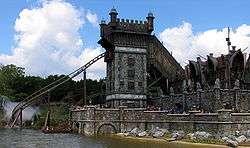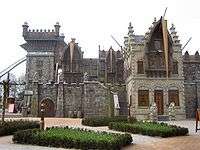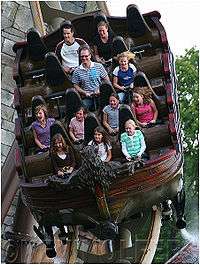De Vliegende Hollander
De Vliegende Hollander ("The Flying Dutchman" in English) is a combination of a water coaster and a dark ride in amusement park Efteling in the Netherlands. It should have gone operational on April 16, 2006 Easter, exactly 328 years after the disappearance of the legendary Dutch man of war the Flying Dutchman; due to construction problems the opening was postponed to April 1, 2007.
| De Vliegende Hollander | |
|---|---|
 | |
| Efteling | |
| Location | Efteling |
| Park section | RuigRijk |
| Coordinates | 51°38′53″N 5°02′51″E |
| Status | Operating |
| Opening date | April 1, 2007 |
| Cost | € 20 million |
| General statistics | |
| Type | Steel |
| Manufacturer | Kumbak |
| Designer | Karel Willemen |
| Track layout | Water Coaster |
| Lift/launch system | Chain lift |
| Height | 73.82 ft (22.50 m) |
| Length | 1,377.95 ft (420.00 m) |
| Speed | 43 mph (69 km/h) |
| Inversions | 0 |
| Duration | 3.43 minutes |
| Capacity | 1900 riders per hour |
| G-force | 0.2-2 |
| Height restriction | 47.3 in (120 cm) |
| De Vliegende Hollander at RCDB Pictures of De Vliegende Hollander at RCDB | |
The coaster carriage
The carriage is designed as a small wooden boat, in which riders are seated below the water level throughout most of the ride. At the front of said boat is a lion's head, holding a lantern in its mouth. The lantern provides low levels of light throughout the ride, further enhancing the eerie atmosphere. The lantern starts flickering, depending on the scene the riders are located in. The carriage holds a maximum of 14 riders at a time, arranged in 4 rows, in which the front row consists of 3 seats, the second of four. Both the third and fourth rows are on an elevated plateau, arranged in the same 3 and 4 seats formation. This is specifically designed to stop anything from blocking the vision of the riders.
The legend and the attraction


Willem van der Decken, a captain of the Dutch East India Company (VOC, the first limited company), is a wealthy trader in command of the fastest ship of the VOC, named the "Hollander" (Dutchman). But greed takes control of him and secretly he starts practicing piracy. He recruits his crew from orphanages.
On Easter 1678, despite a heavy storm blowing into port, he sets sail for the Dutch East Indies. When all despair for this lack of fear for God, he proclaims: "I will sail, storm or not, Easter or not, prohibited or not. I will sail, even into eternity!" (Early Modern Dutch: "Ik zal vaeren, storm of gheen storm, Paesen of gheen Paesen, verbod of gheen verbod. Ik zal vaeren, al is het tot in den eeuwigheid!").
Against the wind he sailed toward damnation.
The house of Van der Decken is part of the scenery for the queue line. After walking through this abandoned house the queue continues down into so-called 'smugglers' tunnels', where Van der Decken's treasure can be seen hidden behind a small door. The tunnel ends in the cellar of a pub in 17th-century style. In the harbor, under a dark clouded sky the coaster ride begins. The 14-person barge goes into open sea where it meets a holographic ghost ship, the Flying Dutchman, and dives under its bow into the Underworld. Here, it halts, and a ghostly voice is heard stating: "You shall also sail until the end of time!" (Early Modern Dutch: "Ook Gij zult vaeren, tot het einde der tijden!") The barge is then towed to a height of 22,5 meters. Doors open and the barge shoots in a curved declination through a tunnel. After this some airtime in a bunnyhop and an 85-degree horseshoe. A steep fall and a left curve bring the barge back into the water. A special technique allows for variation in the size of the “splash”, thus preparing the ride for winter opening.
Music
The music was composed by René Merkelbach and consists of 16 parts that are synchronous with the ride. The Prague philharmonic orchestra performed the music for the recording.
References
| Wikimedia Commons has media related to De Vliegende Hollander. |